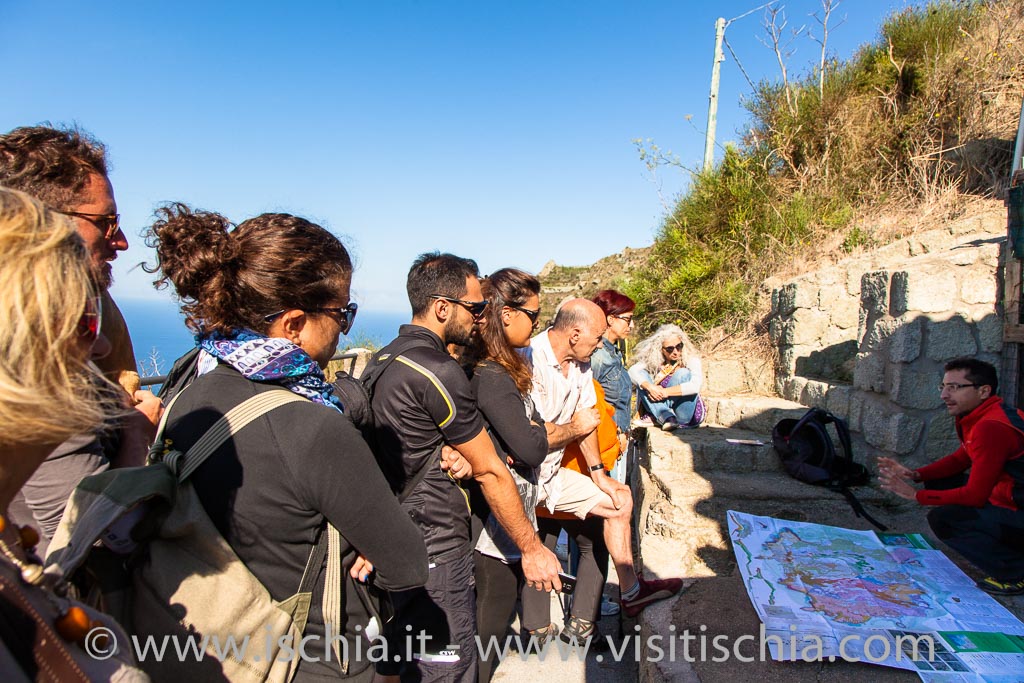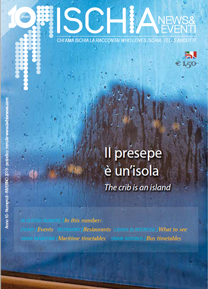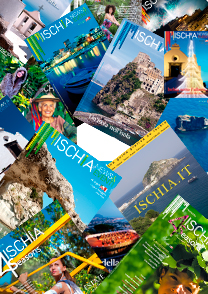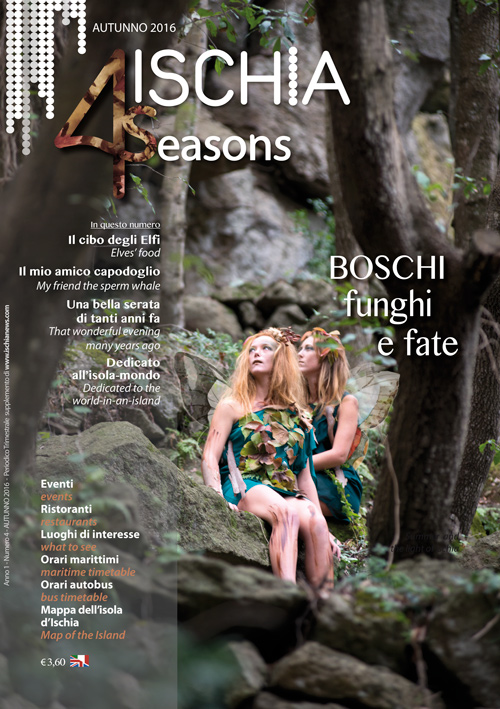Exploring the island of a thousand landscapes

I feel a new energy in the air, sounds, colors, smells, I awaken from winter warmth an-nouncing to me the arrival of spring. It is too strong the lure, I do not resist and certainly do not lose the opportunity to live spring in Ischia in the best way, that is “Going around pathways”. Before starting the way, I strictly control my equipment. Oh yeah! because the success of a hike worthy of respect, starts from the care of these details.
I start with the shoes, comfortable, wa-terproof, but breathable (the Gore-Tex is a great material), and with a suitable sole for rough terrain, then move on to clothing (as they say in general “wearing several lay-ers of clothing”) tak-ing care to choose the breathable technical garments for the most internal and insulating lay-ers (if they were to serve) for those more external. Changing the contents in the backpack is a must. Sunglasses, hat and sunscreen inside the backpack, along with the necessary (paper, compass, GPS, water and dried fruit if I were starving). Last but not least a small first aid kit (you never know!).Well, I’m ready and I’m looking forward to enjoy my island, my green island. One would think once the richness of impetuous flora, especially on the north side, yet it has this name no to vegetation, but to the singular rock, unique in the world, which is the principal framework of the island: the Green Tuff. This will be enough to get by tourism forever! Looking from above, the island shows its volcanic nature. In fact, from a geological point of view, Ischia is a volcanic field, a complex pf several plates raised and inclined, separated by fractures and faults, which served often by way out to the magma of the local basin, thus giv-ing rise to a series of volcanic structures. Many “holes” scat-tered throughout the territory, the many craters, many stories to tell. And I want to start from one of these “holes”, from the first you see from Naples. The port of Ischia, formed in Roman times, later volcanic lake and turned into the port in the Bourbon period. My gaze goes straight up and through Via Quercia, I come to one of the best preserved vol-canic island. They are in the unmistakable green of the Bosco della Maddalena, in Casamicciola Terme, beautiful pine for-est which lies on a volcanic dome and from there I arrive to the border between the Montagnone, covered in wild Medi-terranean maquis and Monte Rotaro reign of a thick pine forest. Crossing the top of the crater and admiring the bot-tom, it continues un-til a series of active “fumarole”. These are certainly one of the most fascinat-ing perspectives of Ischia and with the demonstration of the thermal waters, are proof that Ischia is an alive island, still in activity (we speak in this case of second-ary type volcanism). But the features do not end there; in fact near these fumaroles I found one of the rare species that inhabit the island. It is Cy-perus polystachyus (fumaroles papyrus). Species similar to grass, it is an unusual plant that lives in tropical and sub-tropical areas and in Europe only in Ischia, where it has found its habitat thanks to the land warmed by the steam of the fumaroles, and a mi-croclimate, therefore, humid heat suit-able for its growth requirements.I go on coasting the huge crater of Fondo Ferraro, arriving near the Fiaiano stables. I rest for a moment and I look up and fascinates me a thick chestnut forest. My view is kidnapped by the light color of the chestnut flowers that from Monte Toppo to rise, seems golden strokes in the typical deep green sea of this side of the island, and an indication of a great floristic richness. Go-ing along the valley of Buceto, where there is the epony-mous source, the first section is accompanied by the remains of the old aqueduct that captured water up to the village of Gelsa (modern Ischia Ponte). Given the high exposure of this first section, the predominant veg-etation is typical of the Mediterranean, in which stand out the fragrant essences of myrtle enriched by the aromas of wild mint and thyme. After a while, as if by magic, the land-scape changes: the particular position and geomorphol-ogy of the valley, as well as the wealth of water (precisely the source of Buceto), the presence of tall poplars and trees of heaven with ivy look like liana, and down tall ferns and harnessed with large leaves at least one meter, the chirping of birds, make this stretch like a tropical forest. We are im-mersed in this world, losing for a moment the knowledge of space and time. As in an adventure film I go up the valley, and I enter a forest of chestnut trees at the foot of Mount Trippodi, until arriving in San Paolo Plain, old fossil beach, witness of the past of a submerged part of the island. In fact, for thousands of years (about 60,000 years ago) the central part of the island, following the collapse due to the emptying of the magma chamber, the result of very intense explosive ac-tivity, was positioned in the sub marine environment. This is definitely one of the most significant events of the geolog-ical genesis of Ischia, which is generated the typical rock of the island: the green tuff, formed follow-ing chemical and physical alteration of the pyroclastic rocks, visible today, like the other underwater structures, as a result of the resurgence of the collapsed mass.Continuing the ascent I come up to the highest point of Hörst (that’s how it is defined in techni-cal terms Mount Epomeo: horst volcano-tectonic). At the peak (789 asl) is the church of St. Nicola (hence the name of the peak) with its hermitage carved entirely in green tuff, which for years has stayed hermit Giuseppe D'Argout, former commander of the garrison of Aragon-ese Castle in 1700. The hermitage was later transformed into a charming guest house where rooms were the ancient and silent cells. For about a year it has been tidied up and reopened to the public. A path carved into the stone leads to the summit, sculpted by the wind and bordered with yellow lichens. From here you can enjoy a 360 degree view (hence the origin of the name Epomeo: Epopon or Epopos I look, I aim around). The face is recognizable with the wood of Falanga with Santa Maria al Monte, Monte Nuovo and Forio below. The Pontine islands, not so distant, form a continuous line with the Lazio coast. Glancing toward the North the Phlegrean coast and the islands of Procida and Vivara, Vesuvius, and continuing moun-tains Lattari and the island of Capri. And then the view is lost in the open sea and it has the feeling of being suspended between sky and sea.I awakened and full of renewed energy, I continue along the path (number 501 of the cadastre CAI). I come once in a detour that proceeds through a steep slope that dips in one of the places most “crazy” of the Island. The wood of Fa-langa, where clearly the reality meets fantasy. The wood of Falanga has a ter-race at about 600m above sea level, right at the foot of Mount Epomeo. It is evident, in fact, the area of the fault (the one I came down) that is a majestic wall of green tufa, carved by wind and mottled with lichens, ilex covered, strawberry trees and heather, wherever the slope allows. I am forward-ing in the woods and I have the feeling of entering another dimension. The most moist and cool, allow the spread of deciduous hardwood as predominantly chestnut and which are accompanied by native arboreal elements (different species of oaks). The volcanic and seismic nature of the island of ischia has influenced over the enturies the stories of local people, forc-ing them to continu-ous adaptations to the territory; this has developed an ex-traordinary example of rock architecture, due to the long work of transformation of green tuff boulders tumbled down from Mount Epomeo. The latter, in part are naturally carved by the atmospheric agents (for exam-ple the so-called stone “Perciata”, the characteristic hon-eycomb erosion), and in part have been excavated by men they have gained millstones, deposits and tem-porary shelters. The stone houses are so perfectly integrated with the vegetation and the surround-ing environment, to blend in nature and become precisely why an excellent defense against pi-rate raids. Here they form a real village, which together with the remains of ancient parracine (now covered by vegetation) show traces of a past in which the screws were to dominate the scenery and not the chestnut trees. It’s amazing how is current and readable the past through these signs.While losing myself in this world, I continue my path, until you come to another forest, that of Frassitelli, a dense acacia terrace. Lo-cust trees in the for-est (North American species introduced) alternate with several examples of spurge and various types of fern. The undergrowth and the edges of the paths are character-ized by the pres-ence of valeriane, anemones, violets, psoralee, cyclamen, splints, broom, as well as a series of aromatic and medicinal plants such as the nepeta, savory, dandelion, nettle , camomile, parietaria, thyme, fennel and wild oregano (in summer I make a supply!). But this is also the realm of the wild rabbit that has played and plays a key role in the local cuisine.While I walk, I run into a stone arch, behind which runs a carved staircase leading ... who knows where! ... It is too strong appeal for this new adventure and I divert, up ?the path and finding myself back on the crest of the island, near water Stone (huge green tuff and dug in which a cistern to collect water has been converted into fact). I stop to catch his breath and to enjoy breathtak-ing views. To the left there is the west coast, and to the right the North East one. I shoot every single frame to be sure that the images are fixed well in my memory. Then I go on towards Fontana and more precisely to the hamlet of Noja. From this small village I go down to one of the scenarios that make it the only green island in the Mediterranean Sea. We are in the south-ern part of the island, right on a horse of land between two gorges: the Olmitello to the left and to the right Cava Scura. In a moment we leave the “civilization” to get to a place where the signs of man give way to nature; the whole thing is the setting for some real rock sculptures. Here nature is really fun, carving over time through joint action of endogenous fac-tors (volcanic activ-ity) and exogenous (wind and water) these pyramids: the Pizzi Bianchi. It is enough to have just a little resourceful-ness and courage and you will be immersed in this fruit landscape of the syn-ergy between nature and art. The descent into the gorge (a nar-row gorge between steep rock walls) is truly a unique experi-ence and suitable for experienced and well equipped walkers (including helmet) and leads us up to Maronti Beach, on the southern side of the island. Incred-ible, I crossed the island from side to side, walking half a day, but having the feeling of having walked for days and days. All of this is certainly due to the fact that I have seen so many different environments in such a short time. But the geographical loca-tion of the island, which determines the peculiar climatic conditions, com-bined with a special geo-morphology, represent a unique environment in the Mediterranean Sea, a natural laboratory, where to live and un-derstand the mean-ing of the concept of geo and biodiversity. However I am still not satisfied. My goal is to return to the port of Ischia along a truly spectacular stretch. Going up the old road (via Giorgio Carafà) from Maronti to Testac-cio, and I come up to Vatoliere. I continue to the Church of the “Madonna Montevergine” for a path fraught but fascinating to one of the most beautiful geological sites (sites of geological inter-est) of the island: the “Scarrupata of Barano”, whose walls show fine examples of stratified volcanic materials (tufa, pumice, lapilli, white ashes, trachytic rock). From there I arrive on the head-land and, among vineyards and Medi-terranean maquis, it enters a chestnut that goes all the way up Mount Vezzi, a volcanic dome of 392 m. From here I can see simultaneously the two most famous lava domes of the island: Sant’Angelo and the Castello Aragonese.The descent from the top to Piano Liguori offers me a beautiful view of Punta San Pan-crazio (156 m) with the characteristic church overlook-ing the sea. The islanders vines here enjoy a favorable microclimate, even compared to other island areas, for display at East South-East, for the presence of particu-lar soil, fertilized by volcanic ash and the abundance of seasonal rainfall. Along the way I see old cellars dug into the rock between the area terraces watching the beau-tiful scenery of the open sea which meets the other islands of the Gulf (Procida, Vivara and Capri) and Amalfi Coast. trough vineyards and along the beautiful bay of Cartaromana on the bottom of which are still visible the remains of the "Aenaria" the old Roman submerged Ischia, I continue in a flexible overhanging the path of various creeks in which converge steep terraced vineyards. What an example of heroic viticulture! I get to Campagnano and return to the port of Ischia with renewed energy, with physical, mind and spirit perfectly rebalanced. And it is from this experience that surely I will repeat, that comes the awareness of wanting to enhance and rediscover the island, an island which neverthe-less continues to surprise thanks to the deep and intricate intertwin-ing of natural and anthropogenic fac-tors. In this period it is really nice (re) discover it with the desire and the right spirit, but above all to live these places with the respect they deserve. Wish-ing you the best I expect to meet you “To Paths”. GOOD TRAIL TO ALL!
Andar Per Sentieri 2016 Programma schede percorsi e prenotazione
Di seguito i collegamenti alle schede dei Percorsi di Andar per Sentieri
- PANZA: TRA STORIA E NATURA
- TRA SORGENTI E VULCANI
- NELLA BOCCA DI TIFEO
- CELARIO MONTECITO CRATECA, LA VIA DELL'ALLUME
- DA SERRARA AL FANGO, ATTRAVERSO LE CASE DI PIETRA
- BOSCO DELLA MADDALENA
- IL SENTIERO DELL'EREMO
- VATOLIERE CAMPAGNANO, SOSPESI TRA CIELO E MARE
Programma 2016 Andar per Sentieri
Per info e prenotazione Booking Ischia +39 0813334774 – E-mail This email address is being protected from spambots. You need JavaScript enabled to view it.

































